Mónika Besenyei[1]: The Application of ESG in the Public Sector - Measuring the Sustainability of the Public Administration Sector[1] (JÁP, 2024/1., 181-210. o.)
https://doi.org/10.58528/JAP.2024.16-1.181
Abstarct
In the current global context, Environmental, Social és Governance (ESG) could undoubtedly be a revolutionary tool if it is coupled with the constraints that force not only the issuance of audited non-financial reports but also emphasize the significant impact that the indicators contained therein have on the market position of organizations. Although public administration permeates the economy as a whole and should play a crucial role in achieving sustainable development goals in the modern state, it is still the classic "polluting" industries that are at the centre of recent sustainability initiatives.
The involvement of public administrations would be vital, given that their economic weight remains significant, even when compared to other actors in terms of carbon emissions. The indirect impact of public administrations and the example they set should not be neglected. It would have been worthwhile to make it compulsory for public companies to issue non-financial statements concurrently with their financial statements. At the same time, a framework could be developed within which each specialized public body could work.
Unlike market actors, in the case of public institutions, the decision to introduce ESG reporting could lead to a faster start-up due to centralization. At the same time, it is important to bear in mind that data collection may pose the first major obstacle for many public institutions. However, the integration of operational and management data into an information system could yield benefits beyond ESG considerations, such as identifying cost-saving opportunities.
Keywords: ESG, good governance indicators, sustainability of public administration, sustainable development
- 181/182 -
I. The roles and responsibilities of public administration sector
When looking at the roles and responsibilities of public administration sector from a new perspective, in the context of sustainability, it is worth reviewing the linkages and contexts along which these roles, responsibilities and tasks can be understood. Magyary's definition of public administration[2] as the administration of the state is too general to provide a basis for further analysis.
According to Lajos Lőrincz's organizatorganizational approach, the subsystems of public administration are the individual organs, the activities and functions of the organization, and the staff. Of which the latter subsystem is the one that "sets the organization and the system of functions in action and keeps them in motion."[3]
A more complex, systemic understanding of public administration is that it is the executive branch of government, which can thus take binding decisions to implement state strategies and objectives, and can also use state coercion to enforce them, and "organise and deliver public services"[4] through the established administrative organizational system.
However, this approach also does not make it easier to understand the sustainability mission and objectives, which are increasingly being emphasised by states at the level of public administration.
The closest approach to this is the model presented by András Patyi as a scientific model of French public administration.
The clustering presented here may already be suitable for fitting the UN Sustainable Development Goals and the ESG domains to the functions within each model.
| 1. State sovereignty | 2. Economic functions | 3. Social functions | 4. Cultural and edu- cational functions |
| external sove- reignty internal sovereignty political functions | issuing national currency, specific sectors (energy, waste, utilities, agriculture) economic and financial coordination, regional planning, investment and credit system, taxation, price regulation | healthcare, housing and urban development, protection of interests and social protection, protection and restructuring of certain social structures | scientific research, education, providing information, heritage protection |
Table 1. The French model of public administration
(Source: Patyi, 2017,19.)
- 182/183 -
In a broad sense, the institutional system for implementing public administration includes, in addition to the organizational system of public administration, solutions where the state does not implement tasks directly through its own bodies, but with the involvement of other non-state or semi-state actors. This is called indirect or indirect public administration.
The institutional system of public administration in the broad sense is thus formed by the simultaneous use of direct and indirect solutions, although the proportion of direct and indirect solutions may vary considerably from country to country and from period to period.[5]
II. The public governance and social aspects of sustainability
From a sustainability perspective and for the analysis of ESG linkages, we will look in detail at functions 2, 3, 4, namely economic, social, cultural and educational.
In our understanding of sustainability, function 4 (cultural and educational aspects) is part of pillar 3, the social pillar, so we tend to identify these functions at the level of the individual and society.
Sustainable development and sustainability transition analysis is a relatively newer discipline and research topic. Nevertheless, recognising the importance of the subject, many universities and research centres are now addressing the issue of sustainability transition.[6] The issue of sustainability (unsustainability) itself only became prevalent worldwide in the mid-20th century, as the environmental impacts of socio-economic development became more and more apparent. Given that the initial period was more a period of awakening and identification of problems,[7] the transition to sustainability can only be considered to have taken place when large, long-term, multidimensional and fundamental transformations of large socio-technical systems are taking place.[8] This also means that we understand transition as programmes and/or planning at national level and internationally. It therefore does not mean a passive event or positive changes as a result of individual actions. It is a process of coordinated, conscious and planned action involving several areas (society, technology), with a clearly defined purpose and direction.[9]
Starting from the classical triple bottom line - TBL (People, Planet, Profit) definition comes from John Elkington, founder of Sustain Ability[10] - of sustainable development: environment society (including individual interests) - economy. I
- 183/184 -
start with the definition of sustainable development, which emphasises the harmony between social well-being and natural resources: "sustainable development means improving the quality of human life while remaining within the carrying capacity of supporting ecosystems" (Economics of Natural Resources).[11]
Sustainable development is a term that is commonly used, but no one is quite sure what it means.[12] Defining the concept and content of sustainable development is a recurring issue.[13],[14],[15],[16] It would be important to clarify what we mean by sustainable development in terms of measurability, so that we can identify what is not sustainable and track the direction of change. A more precise definition can be given if we delimit precisely which sub-area we want to study sustainability. In this context, environmental sustainability is defined as "the balance, resilience and interconnectedness that allows the needs of human society to be met without compromising the ability of ecosystems to regenerate, thereby enabling these needs to be met in the long term, without loss of biodiversity as a result of human activities."[17]
The UN 2030 Sustainable Development Goals (SDGs) should be integrated into national plans and strategies to set baselines and enable effective data collection. Measurability is therefore an important part of achieving the goals in this case.[18]
Both the public sector and local governance have to respond to new global and local challenges, and so there are significant changes in their tasks, organizational structures and specific tasks that require new knowledge, new competencies and new tools. This is also reflected in the fact that, in addition to the traditional tasks of modern public administration listed above, tasks closely linked to sustainability are emerging.
For example, climate change, pollution and water use, or the provision of clean energy, which is not only an environmental but also a social issue, both in terms of production and distribution and storage.
"Climate change, global warming and the myriad of negative health and environmental impacts associated with it are a challenge for states, requiring increasing attention and effective solutions compared to new and traditional public administration tasks (home affairs, foreign affairs)."[19]
Of course, environmental and other sustainability issues cannot be treated as a purely domestic matter. "Only extensive inter-state cooperation can ensure the development of costly monitoring and hazard prevention systems, new reg-
- 184/185 -
ulation and coordination of urban and rural planning. These are new tasks that require public and social cooperation, where the efforts of individual countries can only achieve partial success, and where coordinated, planned action is essential for a number of reasons."
The 4th Industrial Revolution, in turn, poses further challenges for public administrations, which must keep pace with exponential growth. All these changes and new demands are increasingly intertwined with sustainable development and the competences required to achieve it. Technological progress, and thus the industrial revolutions, have brought about major transformations in all aspects of their daily lives. Technological and social changes have a combined impact on different social and economic sectors (e.g. education, industry, agriculture, services, and hence employment) and the transformation of these sectors has repercussions on technology and society itself.
The first industrial revolution put the power of water and steam at the service of production. In the second, electricity made mass production possible. In the third, electronics and information technology made it possible to automate processes. Since the middle of the last century, the fourth industrial revolution, building on the third, has blurred the boundaries between the physical, digital and biological worlds by merging technologies (artificial intelligence, robotics, self-driving vehicles, 3-D printing, nanotechnology, biotechnology, etc.)[20]
The third industrial revolution has already brought an uncontrollable amount of information to our desks. The indiscriminate flow of data, knowledge and news that is available to everyone is out of our control. By the time of the 4th industrial revolution, data fraud or theft and cyber-attacks were among the top 10 threats.[21]
The ongoing fourth industrial revolution is not only changing the way society works, it is also transforming individuals themselves. "The digital revolution, and the rapid and free access to information, has enabled greater attention to be paid to previously hidden problems. It makes inequalities visible and less acceptable to most of the world,"[22] says Peter Mauer - Red Cross, Switzerland.
The fact that the world's GDP per capita is growing faster than the world's population is a sign that we could achieve global prosperity. Automation means that less and less human labour is needed to make products. A basic income is no longer a utopia. If we wanted it, no one would have to starve, because the goods produced in the world could ensure "decent poverty" for all. But it is also a real possibility that inequalities, and with them tensions, will continue to grow in the world.
However, economic development has not only led to more comfortable living and prosperity in much of the world but also to increased inequality at the global and regional levels. Meanwhile, the complexity of global problems has increased as environmental pressures have increased (population growth in some parts of the world and consumption growth in others) and globalisation and political
- 185/186 -
and economic tensions have increased. Thus, we are less likely to talk of "just" environmental education, but rather of education for sustainable development, which refers to wider sustainability issues.[23]
"It is naivety or cynicism to claim that economic growth will solve environmental problems, because it is the opposite: it causes them. Especially when economic growth is based, as is unfortunately the case in developing countries, on the use of less than cutting-edge technologies and the growth of environmentally intensive economic sectors (intensive monoculture agriculture, mining, heavy industry, chemical industry, furniture industry based on unsustainable forestry, etc.)."[24]
It is clear from the above, and also from the 2015 UN Sustainable Development Goals[25] that we have reached a point in the 21st century where we are able to recognise the extreme complexity, gravity and urgency of the problem.
And while the goals are now accompanied by action plans and indicators,[26] there is little sign yet that we are up to the challenge. Although theories and calculations have been made on the risks of not taking action[27] and economic analyses of the main risk factors are published year after year[28], it is likely that, in the absence of constraints, these have only found an understanding audience at the academic level.
There has been a clear increase in scientific interest in sustainability issues in recent decades (Figure 1-3).
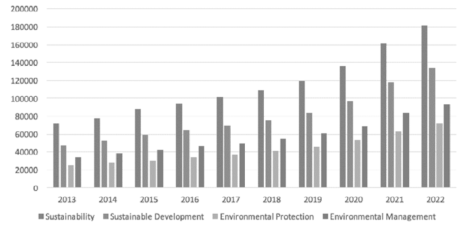
Figure 1. Number of articles registered on Science Direct related to "Suatinability", "Sustainable Development", "Environmental Protection" and "Environmental Management"
(Source: own editing based on Elsevier database)
- 186/187 -
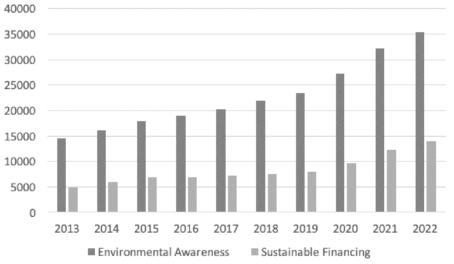
Figure 2. Number of articles registered on Science Direct related to "Environmental Awareness" compared to "Sustainable Financing"
(Source: own editing based on Elsevier database)
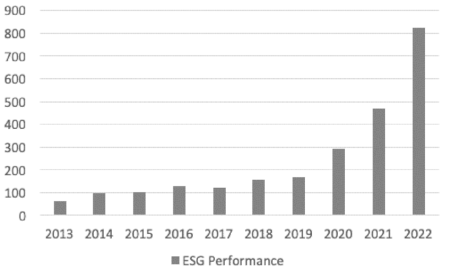
Figure 3. Number of articles registered on Science Direct related to "ESG Performance"
(Source: own editing based on Elsevier database)
However, as scientific interest and research potential have increased, environmental performance indicators have not improved. One only has to look at the change in the global ecological footprint (Figure 4), which, apart from a small reduc-
- 187/188 -
tion in 2008 (financial crisis), has been steadily increasing, indicating an increase in our environmental burden relative to the Earth's carrying capacity. The red area indicates where we have exceeded the limits of the Earth's carrying capacity.
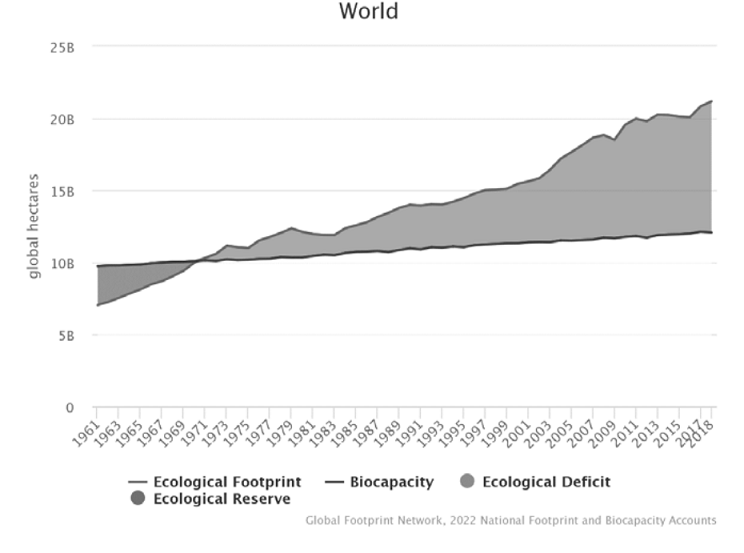
Figure 4. Global Ecological Footprint vs Biocapacity (gha)
(Source: GFN 2022)[29]
While some countries are better off, countries with a significant share of the world's population (e.g. China, India) are experiencing steady growth. Rising incomes and purchasing power are driving consumption, mobility and often waste. Meanwhile, incoming foreign companies tend to relocate their more polluting plants to these countries, which in turn increases industrial emissions, leading to further environmental degradation.[30]
The expected improvement in the environmental status based on the environmental Kuznets curve is therefore not due to economic development (largely due to globalisation).
In his 1955 work[31], Simon Kuznets (Nobel Prize in Economics, 1971) observed that the evolution of income inequality within a society tends to initially
- 188/189 -
increase as national income grows, but once a threshold is reached, these inequalities begin to decrease.
The graph of this relationship is an inverted U-shaped curve. In their 1995 study,[32] Grossman and Krueger show a similar relationship between harmful environmental pressures and national income. This relationship is called the environmental Kuznets curve.[33]
While there are certainly positive trends and efforts (electric vehicles, increasing share of renewables, etc.), overall these cannot reverse the trend. Meanwhile, more and more people are speaking out to urge decision-makers to take account of global threats and take radical action to tackle the problem.
Unfortunately, research also shows that only major global crises such as the financial crisis of 2008 or the COVTD pandemic that started in 2019 have been able to produce results that have even led to a visible reduction in the size of the ecological footprint or carbon footprint.[34] The impact of the COVID epidemic has also brought sustainability and health considerations to the forefront of consumption,[35] which could be considered a further positive outcome if it had brought about lasting change. Unfortunately, however, the lesson of the crises was not the discovery of new lifestyle opportunities and the development of a more frugal behaviour, but that consumption reached its previous level relatively quickly as the threat passed.[36]
There is, of course, an economic dimension to this, which has been a key to the survival of certain service sectors (e.g. hospitality, tourism). In other sectors, however, it was the pandemic that brought about a significant recovery.
The months of COVID closures were also a very exciting time for public administrations. From the organization and financing of services to the management of social aspects, it faced a number of challenges for which it is impossible to be adequately prepared, even if the chances of a pandemic outbreak were significant.
III. ESG as an economic tool to achieve the SDGS
As the EU strives to become the "first climate-neutral continent", it has started to develop a number of instruments to achieve this. At the heart of these are ESG[37] and EU taxonomy as part of wider regulation of market actors, such as the Finance Disclosure Regulation (SFDR) and the Corporate Sustainability Reporting Directive (CSRD). Companies have already taken significant steps to re-
- 189/190 -
spond to the regulatory requirements for ESG reporting. However, this activity is expected to increase further as the scope of reporting obligations continues to broaden and additional regulations are adopted or enacted. Foremost among these is the EU taxonomy, which we expect to define and measure what is and what is not "green".[38]
The EU taxonomy Regulation (2020/852) was adopted in June 2020. It outlines the process of identifying sustainable economic activities that are aligned with one or more of six environmental objectives.
The EU taxonomy is a classification system that makes it possible to determine which economic activities can be considered "environmentally sustainable". An economic activity can be classified as green or "environmentally sustainable" only if it meets the "performance thresholds" set by the EU.
The EU taxonomy also set forth four (4) requirements that economic activities must meet in order to be aligned with the taxonomy:
- making a substantial contribution to at least one environmental objective.
- 'Do No Significant Harm' (DNSH) to any other environmental objective.
- For an economic activity to be certified as being environmentally sustainable in accordance with the Taxonomy, it must make a substantial contribution to at least one of the six environmental objectives while simultaneously having no significant detrimental impact on the other five.
- complying with minimum social safeguards.
- complying with the technical screening criteria.
The six EU environmental objectives laid by the Taxonomy Regulation lays are:
- climate change mitigation,
- climate change adaptation,
- sustainable use and protection of water and marine resources,
- transition to a circular economy,
- pollution prevention and control, and
- protection and restoration of biodiversity and ecosystems.
(European Commission, 2020)
There are three main groups EU taxonomy rules apply to:
- Financial market participants, including occupational pension providers, offering financial products in the EU;
- Large companies are required to report under the Non-Financial Reporting Directive (NFRD), which is set to be revised by the CSRD; and
- The EU and its member states.
- 190/191 -
There are more than 210 SDG indicators available on the SDG Global Database by countries, regions or time period.
For instance, in the case of Hungary, the official database contains 413 data for a single year (2020). It is clear that the tracking of these data and their use for decision-making requires considerable resources. The weighting between indicators is not clear either, although there is flexibility at the country level. Priorities are decided on a region-by-region and country-by-country basis, taking into account local specificities and areas of development.[39]
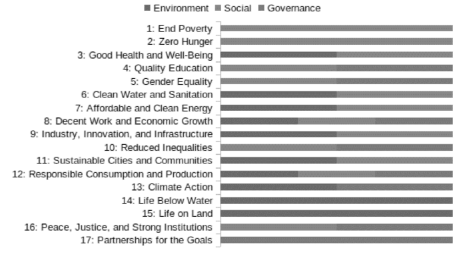
Figure 5. ESG dimensions of the Sustainable Development Goals
(Source: SustainoMetric)[40]
IV. The role of ESG in promoting sustainable public administration
The ESG aims in part to address greenwashing. It is also an important objective to serve as a tool for economic actors to accelerate progress towards the SDG targets. Although the targets are usually interpreted at the country level, implementation cannot be envisioned without the cooperation of all actors in the economy.
This also means that public resources can only achieve their purpose if they are used by the right firms in the right places to foster a sustainable economic transformation. It is therefore necessary to give priority to those companies that have a sustainable performance. But clear requirements are needed to give preference. In other words, it must be well-defined and measurable when a company is considered sustainable.
- 191/192 -
In the SDGs, goal 16 addresses the main public service tasks., namely 16.1, 16.2, 16.4 and 16.a put a great deal of emphasis on the monopoly of violence governments are entrusted with: ensure the safety of citizens and prevent violence by other groups. It sets, second, the basic rights of citizens: enjoying a legal identity (16.9), participating in decision-making (16.7), and accessing justice (16.3). Finally, it establishes some principles of good administration: promoting the rule of law (16.3), protecting fundamental freedoms (16.10), corruption-fighting (16.5), non-discrimination (16.b), access to information (16.10), and effectiveness, accountability and transparency of public administrations (16.6)."[41]
In summary, the ESG EU Taxonomy is a new tool designed (and still being developed) to support the EU's Green Deal objectives. It aims to ensure that not only the governments and individuals are responsible for the sustainability transition success, but also the companies. The missing link to its success has been the financial sector because it has a crucial role to play in enabling the move to a green and sustainable economy. It is obvious that sustainability cannot be achieved solely through regulation but requires the alignment of market interest.
As I have already cited, the EU has committed to become carbon-neutral by 2050 and has created the European Green Deal. This is a system of rules and guidelines to accelerate the green transition. The EU Action Plan on Sustainable Finance was created as a new tool of the European Green Deal, to foster financing the transition by encouraging more funds of the investors to be invested into sustainable projects, assets and companies. The EU taxonomy serves as a key element of this plan.
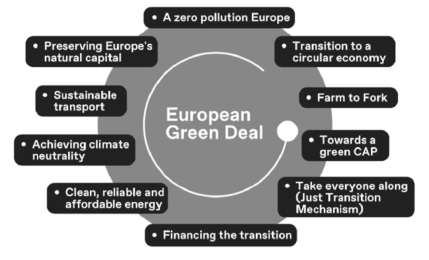
Figure 6. The sustainability initiatives of the EU Green Deal
(Source: Crabbendam and Descio)[42]
- 192/193 -
1. The ESG framework and its uses
Environmental, Social and Governance (ESG) frameworks are sets of guidelines that help companies manage their ESG commitments. They also provide direction on how to create ESG reports, which are used to document and disclose ESG progress.
From different perspectives, there are different approaches that better describe the essence of ESG. From an investor perspective, ESG is a risk management tool.
Sustainability rating agencies base their ratings on the inherent sustainability risk of a company, and how a company manages those risks. The ESG rating agencies analyse the information of the disclosures in the ESG reports of the companies or direct communication between the analysts and the companies. Companies can perform an ESG risk analysis and decide what topics are financially material to their performance using one of the reporting standards. During the ESG risk analysis process, the company has an opportunity to re-align its purpose, strategy, and performance metrics.
From the perspective of business partners and individual citizens, ESG is a transparency tool. However, for business partners, ESG performance is also of paramount importance from an investment perspective because of the focus on the supply chain. It greatly facilitates the achievement of ESG targets and reporting if a company chooses suppliers that are themselves ESG compliant.
It could be said that ESG and the EU Taxonomy have stirred the "standing water" of CSR.
A combination of the depletion of CSR reporting and the lack of measurability of sustainability performance has led to the establishment of this market regulator, which is intended to encourage investment in a "green direction".
The three pillars of ESG refer to the sustainability basic elements: environmental, social, and governance. Unlike the TBL presented earlier, ESG takes a horizontal view of the economic aspects.
The environmental factors refer to an organization's environmental im-pact(s) and risk management practices. The social pillar refers to an organization's relationships with stakeholders, but also an organization's impact on the communities in which it operates.
A hallmark of ESG is how social impact expectations have extended outside the walls of the company and to supply chain partners. The governance, or corporate governance, refers to how an organization is led and managed. It refers to how leadership's incentives are aligned with stakeholder expectations and what types of internal controls exist to promote transparency and accountability on the part of leadership.[43]
- 193/194 -
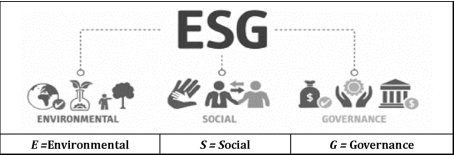
Figure 7. Symobols of the three pillars of ESG
(Source: EU definitions)
| Environmental | Social | Governance |
| Climate Strategy | Equality | Salary |
| Biodiversity | Diversity | Board composition |
| Renewable energy | Consumer protection | Tax strategy |
| Water management | Health and safety | Accounting standards |
| Energy efficiency | Training and develop- ment | Bribery and corruption |
| KIR systems | Supply chain transpar- ency | Ethics and values |
| Carbon neutrality | Human rights | Transparency |
| Waste management | Data protection | Shareholders' rights |
| Transportation | Work/life balance | Remuneration |
Table 2. The pillars of ESG with example elements
(Source: Own work based on EU definitions)
- 194/195 -
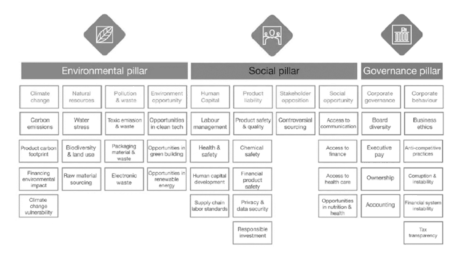
Figure 8. The ESG dimensions
(Source: PwC, 2022)[44]
When talking about the elements of the ESG pillars, it is important to map the links of ESG pillars to the Sustainable Development Goals - the global sustainability compass. As I mentioned earlier, it is important to conceptualize ESG within the context of global trends. The SDGs are the conceptual framework within which country leaders think about the attainment of sustainable development. As such, the ESG has been one of the missing tools to get the business sector in motion.
- 195/196 -
| Environmental | Social | Governance |
| 6. Clean Water and Sanitation 7. Affordable and Clean Energy 9. Industry, Innovation and Infrastructure 11. Sustainable Cities and Communities 12. Responsible Con- sumption and Produc- tion 13. Climate Action 14. Life Below Water 15. Life on Land | 1. No Poverty 2. Zero Hunger 3. Good Health and Well-being 4. Quality Education 5. Gender Equality 6. Clean Water and Sanitation 8. Decent Work and Economic Growth 9. Industry, Innovation and Infrastructure 10. Reduced Inequality 12. Responsible Consumption and Production 16. Peace and Justice Strong Institutions | 5. Gender Equality 8. Decent Work and Econo- mic Growth 9. Industry, Innovation and Infrastructure 11. Sustainable Cities and Communities 12. Responsible Consump- tion and Production 13. Climate Action 16. Peace and Justice Strong Institutions 17. Partnerships to achieve the Goal |
Table 3. The 17 SDGs by ESG category
(Source: Sœtra, 2021)
V. The relationship between the functions of public administration and sustainability frameworks
Public administration tasks cover the administrative services needed to help build and strengthen society. Public administration plays an important role in ensuring that laws and regulations, civil rights, municipal budgets and health and safety codes are enforced to protect the community they serve.
The EC nominated a Technical Expert Group (TEG) which issued its final summary report on the Taxonomy Regulation in March 2020. The TEG decided to employ the NACE2 industrial classification system of economic activities for defining the technical screening criteria of the EU taxonomy. However, the EU Taxonomy aims to have extensive coverage, with 72 economic activities included, those activities were prioritised according to their contribution to total GHG emissions in the EU in 2017.
- 196/197 -
| NACE Macro-sector | GHG (1000 Tonne) | Share of GHG (% of GHG from all NACE Macro-sectors) |
| A. Agriculture, forestry and fishing | 520,860 | 14.7% |
| B. Mining and quarrying | 79,624 | 2.3% |
| C. Manufacturing | 846,421 | 23.9% |
| D. Electricity, gas, steam and air conditioning supply | 1,072,529 | 30.3% |
| E. Water supply, sewerage, waste management and remediation | 163,285 | 4.6% |
| F. Construction | 60,058 | 1.7% |
| H. Transportation and storage | 535,602 | 15.2% |
| J. Information and communication | 10,396 | 0.3% |
| L. Real estate activities | 6,246 | 0.2% |
| Total A-F, H, J, L | 3,295,022 | 93.2% |
Table 4. Prioritised sectors based on CO[2] emission
(Source: OECD, 2020)[45]
Because the public administration sector has not yet been included in the prioritised sectors, there are currently no specific technical screening criteria for this sector.
Based on common interests, there is a growing need for the public administration sector to participate in non-financial reporting initiatives and demonstrate the usefulness of ESG initiatives. It is evident from the indirect impact of governmental operations, priorities, decision-making processes, resource reallocation strategies, and the role of the public administration sector as a promoter of the transition to sustainable development.
- 197/198 -
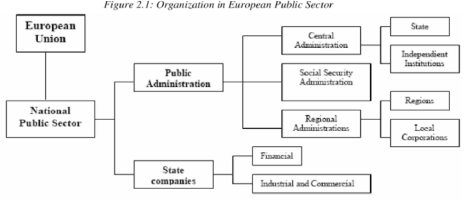
Figure 9. Organization in the European Public Sector
(Source: Maroto - Rubalcaba, 2005)[46]
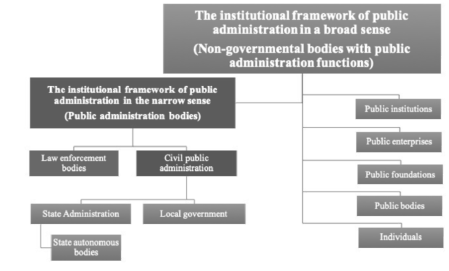
Figure 10. The institutional framework of public administration in a broad sense
(Source: Árva et al., 2014)[47]
The public-sector organizations (PSOs) are experiencing accountability pressure from stakeholders due to their pivotal role in society. PSOs are expected to deliver services and create public value in compliance with the principles of economic, environmental and social sustainability.[48]
- 198/199 -
Such expectations refer to various PSOs, including - among others - national and local governments, state-owned enterprises, higher education and healthcare institutions. Sustainability entails responsibilities for long-term value creation and is not always compatible with the information provided via traditional financial reports.[49]
As de Oliveira Bellini and co-authors summarize in their paper, there is ample evidence suggesting that sustainability reports from the public sector should be the focus of interest. This sector plays a pivotal role in promoting sustainable development, and governments rely on sustainability factors when defining their agendas to meet overarching objectives for which they are responsible. On the other hand "the public sector has the civic responsibility of properly managing public goods, resources, and facilities with the aim of supporting sustainable development objectives and promoting public interest, and its organizations should be open and transparent in managing their actions." Due to their size and influence, public agencies are expected to take the lead by publicizing their activities in order to promote sustainability.[50]
One of the validated reporting frameworks is the most appropriate way to produce high-quality reports, both in terms of content and format. Regarding the reporting standards and frameworks, there is still a confusing abundance on the market.
There are several ESG standards, frameworks and ratings which aim to support the non-financial reporting practices.
- European Financial Reporting Advisory Group (EFRAG) Sustainability Reporting Board
- Global Reporting Initiative (GRI)
- Sustainability Accounting Standards Board (SASB)
- International Sustainability Standards Board (ISSB)
- Climate Disclosure Standards Board (CDSB-initiative of CDP)
- International Integrated Reporting Council (IIRC)
- Task Force on Climate-Related Financial Disclosures (TCFD)
- Global Real Estate Industry Benchmark (GRESB):
- Dow Jones Sustainability Indices (DJSI):
- Bloomberg Terminal ESG Analysis:
- Institutional Shareholder Services (ISS E&S) Quality Score (ISS):
- CDP (formerly known as the Carbon Disclosure Project)
- MSCI ESG Ratings
- S&P Global Corporate Sustainability Assessment (CSA)
- Sustainalytics
- Vigeo Eiris
- 199/200 -
The not complete list is based on the information of Green Business Bureau[51] and Novisto[52].
However, there is a promising agreement between the five benchmark entities in sustainability matters, CDP (formerly the Carbon Disclosure Project), Climate Disclosure Standards Board (CDSB), Global Reporting Initiative (GRI), International Integrated Reporting Council (IIRC) and Sustainability Accounting Standards Board (SASB), will allow for a single standard reporting model that connects sustainability data with financial information.[53]
There is some difference between "standards" and "frameworks". A standard is a specific set of requirements for reporting. It contains detailed criteria, of "what" should be reported on a specific topic. Standards involve a public interest focus, independence, due process, and public consultation, strengthening the basis of what is being asked. A framework is a set of principles providing guidance but not the methodology of collection or reporting itself.
When to use frameworks instead of standards? It could work when a specific standard does not exist, or when the specific organization has a strong internal driver to develop its own standards, which might be even more sophisticated or more appropriate to the context than existing ones.
We would face certain difficulties when trying to find the right industry standards that align with the activities of the public administration sector. It is not challenging to deal with those public activities that exist in the business sector - such as healthcare, transportation, education or urban development. In those cases, applying the standards means choosing the right sector and enlarging the scope and aims according to the governmental strategy. It is still crucial to select the proper performance indicators since they are not solely determined by the overall goals. It is also a disturbing aspect how those institutions could manage data collection according to the guidelines of the standards.
There is a more important task at hand: determining the reporting structure of the public administration itself. This is not only because of social responsibilities - although that should be the main consideration - but also because of the economic, employment, and social cohesion aspects. Evidently, those aspects are interlinked. However, given that one crucial mission of the ESG is to influence the economy through reporting tools, it is important to highlight the economic weight of public administration.
- 200/201 -
| Year | Number of employees: Public administration and defence; compulsory social security (NACE: O) | Administrative staff as a percentage of total employment | Average annual wage bill (based on employer expenditure) billion HUF |
| 2010 | 327.17 | 8.45% | 1 021.74 |
| 2011 | 317.27 | 8.13% | 1 042.50 |
| 2012 | 333.11 | 8.41% | 1 145.75 |
| 2013 | 377.73 | 9.37% | 1 343.81 |
| 2014 | 414.43 | 9.81% | 1 518.99 |
| 2015 | 455.96 | 10.52% | 1 743.14 |
| 2016 | 482.82 | 10.77% | 1 959.33 |
| 2017 | 474.79 | 10.44% | 2 089.92 |
| 2018 | 437.72 | 9.50% | 2 097.01 |
| 2019 | 419.73 | 9.04% | 2 204.70 |
| 2020 | 406.57 | 8.83% | 2 343.31 |
| 2021 | 424.85 | 9.17% | 2 528.00 |
Table 5. The socio-economic importance of the Hungarian public administration in figures
(Source: KSH, 2022,[54] HR portal, 2022[55])
In the next chapter, I will illustrate the implementation by examining the connection between the various functions of public administration sectors (according to the model used by Patyi) and the SASB sectoral standards. Establishing some of these links might seem self-evident, while determining others require a creative approach.
In order to map the materiality and determine the ESG key performance indicators for monitoring, enhancement, and reporting, it is imperative to comprehensively map and define each sector of activity in accordance with the reporting standards. This process completes the materiality map, which best describes the activities of the organization.
- 201/202 -
| SASB sector classification | |
| State sovereignty | |
| external sovereignty | Services/Professional & Commercial Services |
| internal sovereignty | |
| political functions | |
| Economic functions | |
| issuing national cur- rency | Services/Professional & Commercial Services |
| specific sectors (en- ergy, waste, utilities, agriculture) | Renewable Resources & Alternative Energy Infrastructure/ Electric Utilities & Power Generators, Gas Utilities & Distributors, Real Estate, Real Estate Services, Waste Management, Water Utilities & Services Food & Beverage/Agricultural Products, Meat, Poultry & Dairy, Processed Foods |
| economic and financial coordination, regional planning, | Services/Professional & Commercial Services Financials/ Asset Management & Custody Activities, Commer- cial Banks, Consumer Finance, Insurance, Investment Banking & Brokerage, Mortgage Finance, Security & Commodity Exchanges |
| investment and credit system, taxation, price regulation | |
| Social functions | |
| healthcare, | Health Care/ Health Care Delivery, Health Care Distributors, Managed Care |
| housing and urban development, | Transportation/Rail Transportation, Road Transportation |
| protection of interests and social protection, | Food & Beverage/Restaurants |
| protection and re- structuring of certain social structures | Services/Professional & Commercial Services |
| Cultural and educational functions | |
| scientific research, | Services/ Education Services/Professional & Commercial Services |
| Education, | Services/ Education |
| providing information, | Technology & Communications/Internet Media & Services, Tele- communication Services Services/ Advertising & Marketing |
| heritage protection | Services/Professional & Commercial Services |
Table 6. Assessing public administration functions from an ESG perspective (example sectoral standards)
(Source: Made by the Author)
- 202/203 -
In practice, industry classifications remain flexible. According the register of the SASB reporting, the 110 organizations with the word "public" in their name, which may indicate that they are public institutions, public companies, or administrative bodies, are grouped into 38 sectors. The most common of these is the Asset Management & Custody Activities, and the Commercial Bank. Considering this, it is understandable that non-financial reporting requirements were first introduced to the financial sector.
In Hungary, the Hungarian National Bank has been mandated to develop a recommendation to financial institutions on the use of non-financial reporting.
My recommendation for the rest of the public administration, which does not fit into any of the specific sectors, is to implement the "Services/Professional & Commercial Services" standards, because they are broad enough and overlap with the rest of the public service sector according to the description given by the SASB.
"The industry includes companies that rely on the unique skills and knowledge of their employees to serve a range of clients. Offerings include, but are not limited to, management and administration consulting services, such as staffing and executive search services; legal, accounting, and tax preparation services; and financial and non-financial information services."[56]
However, it is essential for the public sector to have specific standards and an EU Taxonomy classification, even if it is not considered a priority based on the carbon emission. But just like Scope 3 in the ESG, the indirect emission of the public sector could be much larger than the direct emission of some prioritized sector emission. It is also important to consider that not only the amount of carbon emissions, but also the trend in emissions is key to achieving zero emissions. "Between 1995 and 2015, global scopes 1, 2, and 3 emissions grew by 47%, 78%, and 84%, to 32, 10, and 45 Pg CO2"[57].
- 203/204 -
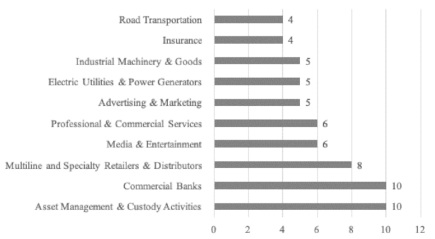
Figure 11. Classification of companies according to SASB sectoral standards
(Source: Made by the author, based on the EC 2023 data and information)
Once an organization is properly aligned with one or more sector standards, a materiality assessment can be undertaken, which is the basis for data collection and the selection of key performance indicators, and thus for the preparation of a quality report.
A more appropriate solution for public administrations would be for the legislators to focus more on this issue and present it as a sector in its own right, recognising the importance of the sector. In parallel, public administrations should be among the first to develop a reporting framework (based on the EMAS data) and be allowed to join the ESG system leading by example.
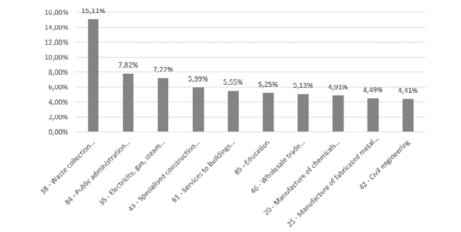
Figure 12. EMAS registered entities by sectors
(Source: EC, 2023)
- 204/205 -
Despite the many tools available to foster a sustainable transition, governments' efforts are still lagging behind. The reason for not focusing on the public sector in the case of EMAS may be explained by the target group of the manufacturing enterprise sector (Honkasalo, 1998), which was initially targeted. However, in the case of ESG, where the green reform was launched with a clear economic actor in mind - financial institutions - there is no reason for public sector organizations not to be obliged to implement an ESG strategy, to report and to be audited.
Where should one start? The answer seems simple. The sustainable transformation of public procurement and employment are two of the most important areas where the introduction of ESG thinking in the public sector could make significant breakthroughs, both environmentally and socially.
Regarding the direct aspects, all the institutions could and should analyse their own operations. General government expenditure in the EU on "general public services" amounted to €875 billion or 6.0 % of GDP in 2021. Furthermore, it is very complex to examine and manage the cost systems in the public sector. This is because of the complexity of public administration, the nonexistence of a standardized and well-tested cost methodology in the public sector. Therefore it is even more challenging to track ESG aspects. Every year in the EU, over 250 000 public authorities spend around €2 trillion (around 13.6% of GDP) on the purchase of services, works and supplies.
The indirect but still manageable aspects are the public procurement topics. The share of public procurement varies across the EU. The average total general government expenditure in the EU is around 50% of the GDP (France had the highest at 59% in 2021), while in Hungary in 2021 it was 48.4% of the GDP. The highest expenditure categories are education, general public services, economic affairs, health, old age, and social protection (which amount to around 22% of the total general government expenditure). These figures draw attention not only to environmental issues but also to the social dimension.[58]
VI. Conclusions
While public administration permeates the economy as a whole, and should play a crucial role in the modern state in achieving sustainable development goals, we see that the classic "polluting" industries are still the focus of recent sustainability initiatives.
ESG will undoubtedly be a revolutionary tool if it is coupled with the constraints that force not only the issuance of audited non-financial reports but also emphasize the significant impact that the indicators contained therein have on the market position of organizations.
- 205/206 -
The involvement of public administrations would be vital, not only because their economic weight cannot be diminished, even when compared to actors in terms of carbon emissions. In this context, it would also be important to measure the carbon footprint of economic sectors in an ESG-compatible way as soon as possible, not only taking into account direct emissions, but also digging down to scope 3 when making the inventory.
In addition, the indirect impact of public administrations and the example they set should not be neglected. It would have been worthwhile to make it compulsory for public companies to issue non-financial statements at the same time as financial statements. At the same time, a framework could be developed within which each specialised public body could start to work.
Unlike market actors, in the case of public institutions, the decision to introduce ESG reporting could lead to a faster start-up due to centralization. At the same time, we should bear in mind that data collection may represent the first major obstacle for many public institutions. However, the integration of operational and management data into an information system would also have benefits beyond ESG, such as identifying cost-saving opportunities.
Theere has been little mentioning of the social study in this study, but this should be the subject of further analysis. By definition, public administration is a system of bodies set up to serve the public good. Nevertheless, there is still a lot of room for improvement in the identification of stakeholders and in understanding their needs.
Bibliography
• Argento, Daniela - Culasso, Francesca - Truant, Elisa (2019): From sustainability to integrated reporting: The legitimizing role of the CSR manager. In: Organization & Environment. 32(4).
• Árva Zsuzsanna - Balázs István - Barta Attila - Veszprémi Bernadett (2014): Magyar Közigazgatási Jog. Általános rész. I. Kötet. Debreceni Egyetemi Kiadó, Debrecen.
• Avelino, Flor - Grin, John - Pel, Bonno - Jhagroe, Shivant (2016): The politics of sustainability transitions. In: Journal of Environmental Policy & Planning. 18(5). DOI: https://doi.org/10.1080/1523908X.2016.1216782.
• Balázs István. (2018): A közigazgatás. In: Jakab, András - Fekete, Balázs (eds.): Internetes Jogtudományi Enciklopédia. ORAC Kiadó - Társadalomtudományi Kutatóközpont Jogi Intézete, Budapest.
• Barua, Akrur. (2021): A spring in consumers' steps: Americans prepare to get back to their spending ways. In: Economics Spotlight. 28.07.2021. (Available at: https://www2.deloitte.com/us/en/insights/economy/us-consumer-spending-after-covid.html. Accessed on: 15.08.2023).
• Boda Zsolt (2006): A gazdasági globalizáció környezeti hatásai. In: Eszmélet. (Available at: http://www.eszmelet.hu/boda_zsolt-a-gazdasagi-globalizacio-kornyezeti-hatasai. Accessed on: 04.08.2018).
• Bouckaert, Geert - Loretan, Rolet - Troupin, Steve (2016): Public Administration and the Sustainable Development Goals. Conference: 15th Session of the United Nations Committee of Experts on Public Administration. International Institute of Administrative Sciences, New York.
- 206/207 -
• CDP Worldwide: Five global ions, whose frameworks, standards and platforms guide the majority of sustainability and integrated reporting, announce a shared vision of what is needed for progress towards comprehensive corporate reporting - and the intent to work,2020. Available at: https://www.cdp.net/en/articles/media/comprehensive-corporate-reporting. Accessed on: 11.09.2020).
• Costanza, Robert Patten, Bernard C. (1995): Defining and predicting sustainability. In: Ecological economics. 15(3). (Available at: https://www.sciencedirect.com/science/article/pii/0921800995000488. Accessed on: 15.08.2023).
• Courtnell, Jane (2022): ESG Reporting Frameworks, Standards, and Requirements. In: Green Business Bureau. (Available at: https://greenbusinessbureau.com/esg/esg-report-ing-esg-frameworks. Accessed on 12.05.2022).
• Crabbendam, Noor - Descio, Carolina (2022): The EU taxonomy explained -Here's what it means for your company. In: Carbon Trust Insights. (Available at: https://www.carbontrust.com/news-and-insights/insights/the-eu-taxonomy-explained-heres-what-it-means-for-your-company. Accessed on: 15.08.2023).
• Daly, Herman E. (1997): Beyond Growth: The Economics of Sustainable Development. In: Beacon Press. Boston, USA.
• de Oliveira, Bellini - Cavalcante, Elyrouse Raimundo - Rodrigues, Nonato - Lagioia, Umbelina Cravo Teixeira (2019): Public Sector (Un) Sustainability: a study of GRI adherence and sustainability reporting disclosure standards in Public Institutions and State-Owned Companies of the Public Agency Sector. In: Cuadernos de Contabilidad. 20(49).
• Elkington, John (2013): Enter the triple bottom line. In: Henriques, Adrian -Richardson, Julie (eds.): The triple bottom line: Does it all add up. Routledge, New York.
• Elsevier: Science Direct, 2022. (Available at: https://www.sciencedirect.com/science/search. Accessed on: 12.05.2022).
• ESG Innovation Team: Novisto, List of Key ESG Reporting Frameworks, Standards and Ratings, 2022. (Available at: https://novisto.com/list-esg-reporting-framework-standard. Accessed on: 15.08.2023).
• European Commission, TEG: Taxonomy: Final report of the Technical Expert Group on Sustainable Finance, 2022.
• European Commission: EMAS Register, 2023. (Available at: https://webgate.ec.europa.eu/emas2/public/registration/list. Accessed on: 12.06.2022).
• European Commission: Sustainable finance. (Available at: https://finance.ec.europa.eu/sustainable-finance_en. Accessed on: 12.05.2022.).
• GFN: Global Footprint Network, Country Trends. 2022. (Available at: https://data.footprintnetwork.org/?_ga=2.140101171.1409923929.1670237930678205174.1670237930#/countryTrends?cn=5001&type=BCtot,EFCtot. Accessed on: 12.05.2022).
• Grossman, Gene M. - Krueger, Alan B. (1995): Economic growth and the environment. In: The quarterly journal of economics. 110(2).
• Hertwich, Edgar G. - Wood, Richard (2018): The growing importance of scope 3 greenhouse gas emissions from industry. In: Environmental Research Letters. 13(10).
• Holden, Erling - Linnerud, Kristin - Banister, David (2016): The Imperatives of Sustainable Development. In: Welford, Richard (ed.): Sustainable Development. Johny Wiley & Sons - ERP Environment, Hoboken, USA. DOI: https://doi.org/10.1002/sd.1647.
- 207/208 -
• Honkasalo, Antero (1998): The EMAS scheme: a management tool and instrument of environmental policy. In: Journal of Cleaner Production. (Available at: https://www.sciencedirect.com/science/article/abs/pii/S0959652697000681. Accessed on: 12.10.2023).
• HR portal: Bérkalkulátor, 2022. (Available at: https://www.hrportal.hu/berkalkulator.html. Accessed on: 12.06.2022).
• Imre Miklós (2016): A közigazgatás kapcsolata a gazdasággal, az államszocializmus és a rendszerváltoztatás gazdasági- gazdaságirányítási átalakulásai Lőrincz Lajos munkásságának tükrében. In: Pro Publico Bono - Magyar Közigazgatás. 2016/3. sz.
• Józsa Zoltán (2019): A közigazgatás funkciói és feladatai. In: Jakab András - Könczöl Miklós - Menyhárd Attila - Sulyok Gábor (szerk.): Internetes Jogtudományi Enciklopédia. ORAC Kiadó - Társadalomtudományi Kutatóközpont Jogi Intézete, Budapest.
• Kates, Robert W. Parris - Thomas M. - Leiserowitz, Anthony A. (2005): Editorial-What Is Sustainable Development? Goals, Indicators, Values, and Practice. In: Environment: Science and Policy for Sustainable Development. 47, no. 3 8-21. (Available at: http://www.environmentmagazine.org/Editorials/Kates-apr05-full.html. Accessed on: 10.11.2022) .
• Kerekes Sándor (1998): A környezetgazdaságtan alapjai. (Available at: http://mek.oszk.hu/01400/01452/html/fenntarthato/index.html. Accessed on: 04.11.2018).
• KSH: 20.1.1.9. Number of employed persons by industries, economic branches and sex
- NACE, 2022. (Available at: https://www.ksh.hu/stadat_files/mun/en/mun0009.html. Accessed on: 12.06.2022).
• Kuznets, Simon (1955): International differences in capital formation and financing. In: Capitalformation and economic growth.. Princeton University Press, Princeton. (Available at: https://www.nber.org/system/files/chapters/c1303/c1303.pdf. Accessed on: 02.02.2024).
• Leal Filho, Walter - Salvia, Amanda Lange - Paço, Arminda - Dinis, Maria Alzira Pimenta
- Guedes Vidal, Diogo - Da Cuncha, Dênis Antônio, de Vasconcelos, Claudio Ruy et al. (2022): The influences of the COVID-19 pandemic on sustainable consumption: an international study. In: Environmental Sciences Europe. 34(1).
• Lélé, Sharachchandra M. (1991): Sustainable development: A critical review. In: World Development. 19(6). (Available at: https://www.sciencedirect.com/science/article/pii/0305750X9190197P. Accessed on: 10.11.2023) .
• Manes-Rossi, Francesca - Nicolo, Guiseppe - Argento, Daniela (2020): Non-financial reporting formats Non-financial reporting formats a structured literature review. In: Journal of Public Budgeting, Accounting & Financial Management.
• Markard, Jochen - Raven, Rob - Truffer, Bernhard (2012): Sustainability Transitions: An emerging field of research and its prospects. In: Research Policy. 41/2012. DOI: https://doi.org/10.1016/j.respol.2012.02.013.
• Maroto, Andrés - Rubalcaba, Luis (2005): The structure and size of the public sector in an enlarged Europe. (Available at: https://www.semanticscholar.org/paper/The-structure-and-size-of-the-public-sector-in-an-Maroto-Rubalcaba/ab73f8148abb1e67e7f0408794de8fbe3404f924. Accessed on: 05.09.2023).
• Morelli, John (2011): Environmental Sustainability: A Definition for Environmental Professionals. In: Journal of Environmental Sustainability. 1(1). DOI: https://doi.org/10.14448/jes.01.0002.
- 208/209 -
• Nagy Katalin (2016): Az oktatás gazdasági értékei. In: Opus etEducatio. 2016/3. sz. (Available at: http://epa.oszk.hu/02700/02724/00008/pdf/EPA02724_opus_et_educatio_2016_03_312-323.pdf. Accessed on: 05.09.2023).
• OECD: The European Union sustainable finance taxonomy. Retrieved 12 05, 2022, from OECD iLibrary, 2020. (Available at: https://www.oecd-ilibrary.org/sites/5e092588-en/index.html?itemId=/content/component/5e092588-en. Accessed on: 05.09.2023).
• OECD: Government at a Glance - 2021 edition, 2023. (Available at: https://stats.oecd.org/Index.aspx?QueryId=107598. Accessed on: 05.09.2023).
• Patyi András (2017): A közigazgatási működés jogi alapjai. Dialóg Campus Kiadó, Budapest. (Available at. https://tudasportal.uni-nke.hu/xmlui/handle/20.500.12944/6919. Accessed on: 05.09.2023).
• Peterdy, Kyle (2022): ESG (Environmental, Social, & Governance) A management and analysis framework to understand and measure how sustainably an organization is operating. In: CFI Education Inc. (Avaiable at: https://corporatefinanceinstitute.com/resources/esg/esg-environmental-social-governance/. Accessed on: 05.09.2023).
• Pettingale, Holly - de Maupeou, Stéphane - Reilly, Peter (2022): EU Taxonomy and the Future of Reporting. Harvard Law School Forum on Corporate Governance. (Available at: https://corpgov.law.harvard.edu/2022/04/04/eu-taxonomy-and-the-future-of-reporting/. Accessed on: 10.10.2022).
• PwC: Environmental, Social & Governance What's it all about?, 2022. (Available at: https://www.pwc.com/mt/en/publications/sustainability/esg-what-is-it-all-about.html. Accessed on: 12.05.2022).
• Rest, Alfred (2002): From" Environmental Education" to" Education for Sustainable De-velopment"-The Shift of a Paradigm. In: Envtl. Pol'y & L. Vol. 32/2002.
• Rugani, Benedetto - Caro, Dario (2020): Impact of COVID-19 outbreak measures of lockdown on the Italian Carbon Footprint. In: Science of the Total Environment. 737, 139806.
• Sœtra, Henrik Skaug (2021): A Framework for Evaluating and Disclosing the ESG Related Impacts of AI with the SDGs. In: Sustainability. 13(15).
• Schwab, Klaus (2015): The Fourth Industrial Revolution: what it means, how to respond. In: World Economic Forum. (Available at: https://www.weforum.org/agenda/2016/01/the-fourth-industrial-revolution-what-it-means-and-how-to-respond/. Accessed on: 05.09.2023).
• Stern, David I. (2004): The rise and fall of the environmental Kuznets curve. In: World development. 32(8).
• Stern, Nicholas (2006): Stern Review: The economics of climate change. (Available at: https://webarchive.nationalarchives.gov.uk/ukgwa/20100407172811/https:/www.hm-treasury.gov.uk/stern_review_report.htm. Accessed on: 05.09.2023).
• STRN: Sustainability Transitions Research Network, 2019. (Available at: https://transitionsnetwork.org/. Accessed on : 03.24.2019).
• SustainoMetric: ESG to SDGs: Connected Paths to a Sustainable Future, 2022. (Available at: https://sustainometric.com/esg-to-sdgs-connected-paths-to-a-sustainable-future/. Accessed on: 12.05.2022).
• Takala, Martti (1991): Environmental Awareness and Human Activity. In: International Journal of Psychology. 26(5). DOI: https://doi.org/10.1080/00207599108247146.
- 209/210 -
• UN: Promotion of sustained economic growth and sustainable development, 2019. (Available at: https://www.un.org/sg/en/content/chapter-ii-promotion-sustained-economic-growth-and-sustainable-development. Accessed on: 11.30.2022).
• UN: Statistics SDG Indicators Database, 2021. Available at: https://unstats.un.org/sdgs/dataportal/database. Accessed on 12.05.2022).
• UN: Sustainable Development Goal indicators website, 2018. (Available at: https://unstats.un.org/sdgs/. Accessed on: 04.11.2018).
• UN: Sustainable Development Goals, 2015. (Available at: https://www.un.org/sustainabledevelopment/sustainable-development-goals. Accessed on: 09.15.2018).
• WEF, W. E.: The Fourth Industrial Revolution [Motion Picture], 2016. (Available at: https://www.youtube.com/watch?v=ChbjZHW2Wwk. Accessed on: 15.11.2020).
• WEF: The Global Risks Report 2018. Geneva: World Economic Forum, 2018. (Available at: https://www.weforum.org/reports/the-global-risks-report-2018. Accessed on: 15.11.2020).
• WEF: The Global Risks Report 2019. Geneva: World Economic Forum, 2019. (Available at: http://www3.weforum.org/docs/WEF_Global_Risks_Report_2019.pdf. Accessed on: 15.11.2020). ■
NOTES
[1] Project no. TKP2021-NKTA-51 has been implemented with the support provided by the Ministry of Innovation and Technology of Hungary from the National Research, Development and Innovation Fund, financed under the TKP2021-NKTA funding scheme.
[2] Józsa, 2019.
[3] Imre, 2016, 152-173.
[4] Balázs, 2018.
[5] Árva et al., 2014.
[6] See the homepage of STRN.
[7] Takala, 1991, 585-597.
[8] Markard - Raven - Truffer, 2012, 955-967.
[9] Avelino, 2016, 557-567.
[10] Elkington, 2013.
[11] Kerekes, 1998.
[12] Daly, 1997.
[13] Lélé, 1991, 607-621.
[14] Costanza - Patten, 1995, 193-196.
[15] Kates - Parris - Leiserowitz, 2005, 1-13.
[16] Holden - Linnerud - Banister, 2016, 213-226.
[17] Morelli, 2011, 1-9.
[18] UN: Promotion of sustained economic growth and sustainable development, 2019.
[19] Józsa, 2019.
[20] Schwab, 2015.
[21] WEF: The Global Risks Report..., 2019.
[22] WEF: The Fourth Industrial Revolution, 2016.
[23] Rest, 2002, 79-85.
[24] Boda, 2006.
[25] UN: Sustainable Development Goals, 2015.
[26] UN: Statistics SDG Indicators Database, 2021.
[27] Stern, 2006.
[28] WEF: The Global Risks Report 2018. Geneva: World Economic Forum, 2018.
[29] Global Footprint Network: Country Trends, 2022.
[30] Boda, 2006
[31] Kuznets, 1955, 19-111.
[32] Grossman - Krueger, 353-377.
[33] Stern, 2004, 1419-1439.
[34] Rugani - Caro, 2020.
[35] Leal Filho et al., 2022.
[36] Barua, 2021.
[37] European Commission: Sustainable finance.
[38] Pettingale - de Maupeou - Reilly, 2022.
[39] UN: Statistics SDG Indicators Database, 2021.
[40] SustainoMetric: ESG to SDGs: Connected Paths to a Sustainable Future, 2022.
[41] Bouckaert - Loretan - Troupin, 2016.
[42] Noor - Descio, 2022.
[43] Peterdy, 2022.
[44] PwC: Environmental, Social & Governance What's it all about?, 2022.
[45] OECD: The European Union sustainable finance taxonomy, 2020.
[46] Maroto - Rubalcaba 2005.
[47] Árva - Balázs - Barta - Veszprémi, 2014.
[48] Manes-Rossi et al., 2020, 639-669.
[49] Argento - Culasso - Truant, 2019, 484-507.
[50] de Oliveira et al., 2019, 1-28.
[51] Courtnell, 2022.
[52] ESG Innovation Team: List of Key ESG Reporting Frameworks, Standards and Ratings, 2022.
[53] CDP: Five global organisations..., 2020.
[54] KSH: 20.1.1.9. Number of employed persons by industries, economic branches and sex, 2022.
[55] HR portal: Bérkalkulátor, 2022.
[56] EC: EMAS registered companies, 2023.
[57] Hertwich - Wood, 2018.
[58] OECD: Government at a Glance, 2023.
Lábjegyzetek:
[1] A szerző tudományos munkatárs, Nemzeti Közszolgálati Egyetem, Környezeti Fenntarthatósági Intézet, egyetemi docens, Széchenyi István Egyetem, Alkalmazott Fenntarthatóság Tanszék. Matematika-fizika szakos középiskolai tanári (ELTE Természettudományi Kar) és környezetmérnöki (Széchenyi István Egyetem, Győr) diplomát szerzett. PhD-fokozatát a Budapesti Corvinus Egyetemen szerezte, ahol disszertációjában a felsőoktatási intézmények fenntarthatósági kezdeményezéseivel foglalkozott. 2005 óta foglalkozik kutatással, valamint fenntarthatósági és oktatási szakértőként és egyetemi projektmenedzserként dolgozik. Kezdetben a környezetirányítási rendszerek területén végzett kutatásokat. Tudományos munkája mellett széleskörű tapasztalatot szerzett hazai és uniós projektek vezetésében, tananyagok fejlesztésében, jelenleg pedig a téma kutatása mellett tanácsadókent és oktatásfejlesztőként dolgozik az ESG rendszerek területén. Emellett a tudatformálást tekinti fő hivatásának. Jelenleg a fenntarthatósági indikátorokkal, a fenntarthatóság szervezeteknél történő megvalósításának eszközeivel, valamint a helyi vagy nemzeti fenntarthatósági erőfeszítések megvalósíthatóságával kapcsolatos kutatásokban vesz részt, elsősorban, de nem kizárólag gazdasági és társadalmi szempontból. Kutatása középpontjában a negyedik ipari forradalom által a fenntarthatóság számára kínalt lehetőségek kiaknázása áll. besenyeimonika@gmail.com

